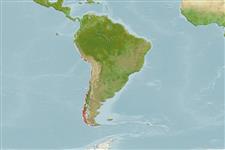Common names from other countries
(كوسه ها و سپرماهيان) (sharks and rays) >
Carcharhiniformes (Ground sharks) >
Pentanchidae (Deepwater catsharks)
Etymology: Bythaelurus: bythos (Gr.), depths of the sea, referring to its deepwater habitat; ailouros (Gr.), cat, probably an allusion to the vernacular “catshark,” so named for its cat-like eyes. (See ETYFish); canescens: Latin for hoary gray, referring to its “uniform greyish” coloration (presumably in spirits since this shark is brown in life). (See ETYFish).
More on author: Günther.
Environment: milieu / climate zone / depth range / distribution range
بوم شناسي
دريايي موجوداتی که در اعماق زیر 200 متر زندگی و تغذیه می کنند; تغييرات عمق 250 - 700 m (Ref. 244). Deep-water; 2°S - 56°S, 81°W - 70°W
Southeast Pacific: Peru and Chile to the Straits of Magellan.
Size / Weight / سن
Maturity: Lm ? range ? - ? cm
Max length : 70.0 cm TL جنس نر / بدون خواص جنسي; (Ref. 244)
Found on the upper continental slopes primarily on mud, but also on rock bottoms. Feeds on bottom invertebrates. Oviparous, with a single egg per oviduct at a time. Not utilized at present.
Life cycle and mating behavior
Maturities | تولید مثل | Spawnings | Egg(s) | Fecundities | توزاد ( لارو)
Oviparous; apparently laying a single egg per oviduct at a time (Ref. 244).
Compagno, L.J.V., 1984. FAO Species Catalogue. Vol. 4. Sharks of the world. An annotated and illustrated catalogue of shark species known to date. Part 2 - Carcharhiniformes. FAO Fish. Synop. 125(4/2):251-655. Rome: FAO. (Ref. 244)
وضعيت در فهرست قرمز IUCN (Ref. 130435)
CITES (Ref. 128078)
Not Evaluated
خطر برای انسان ها
Harmless
استفاده انسانی
ماهي گيري – شيلات: از بی علاقه گی
ابزارها
گزارش های ويژه
بارگيری XML
منابع اينترنتي
Estimates based on models
Preferred temperature (Ref.
115969): 5.8 - 9.5, mean 6.3 (based on 13 cells).
Phylogenetic diversity index (Ref.
82804): PD
50 = 0.5001 [Uniqueness, from 0.5 = low to 2.0 = high].
Bayesian length-weight: a=0.00355 (0.00176 - 0.00714), b=3.09 (2.91 - 3.27), in cm Total Length, based on LWR estimates for this (Sub)family-body shape (Ref.
93245).
Trophic level (Ref.
69278): 4.5 ±0.4 se; based on diet studies.
جهندگی (Ref.
120179): پايين ، كم, كمينه زمان لازم براي دو برابر شدن جمعيت 5/4 – 14 سال (Fec assumed to be <100).
Fishing Vulnerability (Ref.
59153): Moderate to high vulnerability (48 of 100).
Climate Vulnerability (Ref.
125649): Low to moderate vulnerability (34 of 100).
